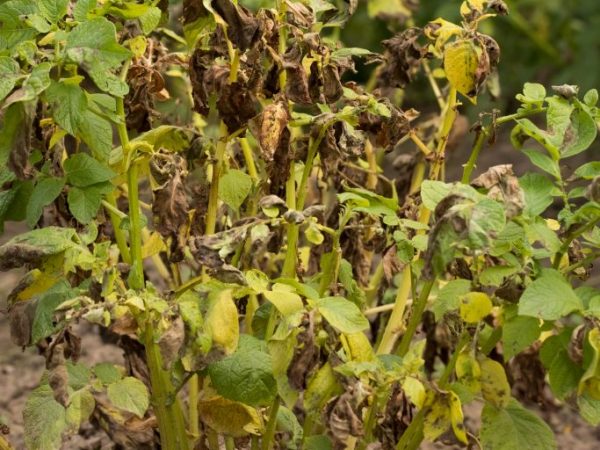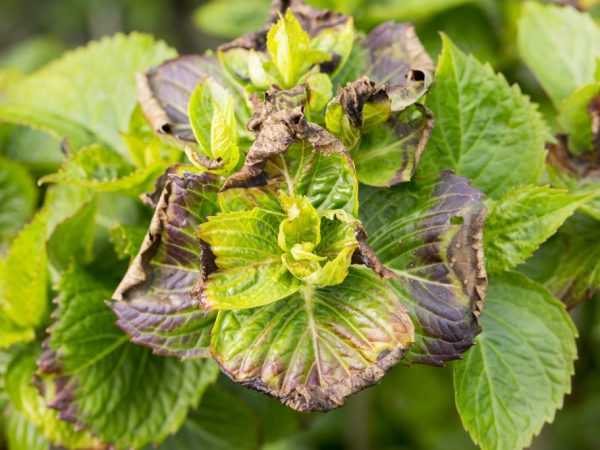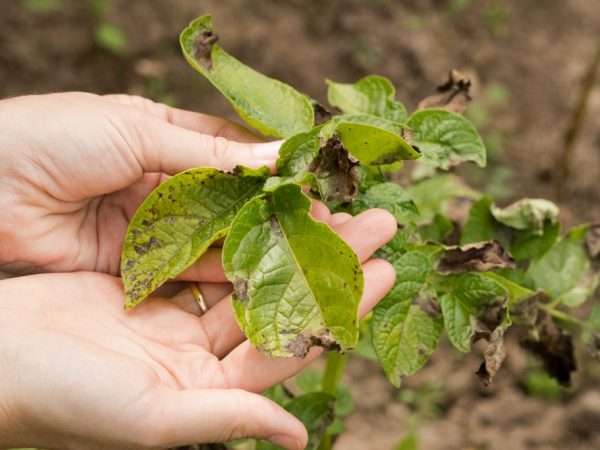Causes of blackening of the tops of potatoes
Experienced potato growers and gardeners - amateurs try to make every effort to get a bountiful harvest of potatoes. They carry out a set of measures for plant care, including watering, feeding, fighting insects and diseases. If all the work is done correctly, then you should not be afraid for the quality of the tubers. Sometimes the weather disrupts plans for plant care and blackened potato tops may appear, which signals that the plants need to be urgently treated.

Causes of blackening of the tops of potatoes
When the tops change color
A natural change in the color of the tops occurs when the potatoes are technically ripe, ready for harvest. In late summer, the bushes dry out, the leaves turn yellow-brown and may fall off. This is a sign of healthy plants and good quality tubers.
If the potato tops wilted and turned black in the midst of the growing season, then we can assume that the plants are affected by the disease. Pathogenic changes can be caused by diseases such as:
- late blight on tops and tubers;
- fungal alternaria;
- dry rot;
- black scab;
- blackleg.
Potato tops and leaves turn black gradually, then they dry out or rot. The formation of chlorophyll is disrupted in the cells, and nutrients do not reach the tubers.
Late blight
The most dangerous among all diseases is late blight.
The disease begins with the penetration of an oomycete (microscopic organism) into plant cells. The rapid multiplication of this parasitic organism leads to a rapid infection of the entire area with potatoes.
The leaves are the first to suffer in case of illness and its symptoms can be easily detected. A fluffy whitish bloom appears on the bottom of each leaf blade, gradually expanding and turning into brown wet spots. If the weather is humid, then the bush completely rots, and in dry and hot weather, the plant dries up.
Infecting the aerial part of the plant, the oomycete, through the capillaries of the tops, moves to the area of the root system and infects the tubers. They also stain, rot, and smell unpleasant. The disease is spread by contact with infected melt water or sporangia are transferred to shoes and tools.
Alternaria
This fungal disease begins a couple of weeks before bud formation, when the potato grows vigorously.
Necrotic black spots appear on the lower leaves and spread up the stems.

Fungal diseases
It is almost impossible to save the crop because, penetrating into the tubers, the fungus destroys the structure of the pulp. The fruits rot and become the cause of soil contamination with pathogenic fungi. Spores get to the site in the same way as the causative agent of late blight.
Fusarium
The cause of this disease is the fungus, which is introduced into the tissues of the plant, during the period of mass opening of the buds.
Leaves dry from bottom to top, curl and fall off.
Infected tubers, during storage, become covered with dry rot, black spots appear on them. The period of intense damage occurs in the middle of winter.
Rhizoctonia
The black scab fungus penetrates the vessels and capillaries of the plant.
The veins on the stems and leaves acquire a brown tint. A young plant can completely rot, and lignified shoots thicken and dry out.
It is difficult to notice fungal damage on tubers. Its sclerotia are like small lumps of dirt. But if the dirt is easy to wash off, then the spore colonies are firmly attached to the skin.
Blackleg
In rainy weather, this disease most often develops.
It affects young shoots at the base of the bush. The tops and leaves turn black, become covered with fluffy rot and die, becoming the source of a new wave of disease.
The plant begins to rot from below, black damp spots appear and the feeding of tubers that have managed to set stops. Therefore, the fruits rot as soon as they appear. If the stolons did not have time to form, then the aboveground part and the root system rot completely.
Fight potato diseases
When the first signs of disease are found, it is necessary to immediately start treating plants. Various methods of saving potatoes are suitable for this.
- Spraying is carried out with a solution of Bordeaux mixture.
- Copper oxychloride is used for foliar treatment.
- Plants are processed using folk methods.
- Protect plantings with chemicals.
In a small area, you can remove the affected parts of the plants and then process the tops of the potatoes. It is not possible to do this kind of work in the industrial areas of potatoes.
Solutions of Bordeaux mixture and copper oxychloride are prepared according to the instructions. Spray the leaves very carefully, capturing both sides of the leaf blade. The procedure is repeated every 7 days.
Traditional methods
Popular methods of treatment include the treatment of bushes with substances such as:
- milk;
- serum;
- water infusion of garlic;
- iodine solution;
- Trichopolum tincture on superphosphate.
Dairy products are diluted with warm water 1: 1 and sprayed with a spray bottle over the area, covering all surfaces of the bush and leaves.
Chopped garlic is poured with water 1: 1 and insisted at room temperature for 2 days. Filter and dilute with water 1:10. After that, the plants are sprayed.
Sometimes iodine treatment is combined with spraying milk or whey solutions. When using one iodine and when combining it with other drugs, it is necessary to introduce 15 drops per 1 liter of liquid, which will be enough so as not to burn young leaves and shoots.
A weak solution of superphosphate is infused for 1 day and 1 tablet of Trichopolum per 1 liter is added to it. Mix well and process the plants.
Prophylaxis

Copper cuparos will help
Instead of treating plants, it is better to prevent the development of pathogenic fungi and viruses. To do this, you must follow the rules for preparing the site and seed material.
Fitosporin-M is used for soil disinfection, it is prepared according to the instructions on the packages. You can spill the soil with a solution of copper sulfate, with a concentration of no more than 1%.
Before planting potatoes, it is advisable to sow siderates in the fall. The best precursors to potatoes are legumes such as beans, beans, and peas. You can also sow winter cereals or white mustard.
When planting tubers, they are pretreated with copper sulfate. For 1 liter of water, 0.3 g of the substance is needed. You can use the chemical Maxim, and for disinfection with organic biofungicides, Agat-25K is chosen. It disinfects tubers and stimulates sprouting.
Potato processing
After the emergence of seedlings, you can begin to work to protect plants from viruses and fungi. Prophylaxis against diseases, with any of the drugs, must be carried out during the growing season of the potato, at intervals of 2 weeks.
A good result is obtained by mulching the ridges with chopped straw or hay.In this case, a hay bacillus develops in the mulch, which is capable of destroying sporangia of any kind of fungi.
After harvesting, tubers should not be left to dry directly on the site. It is better to pre-prepare a shaded place and transfer the potatoes there. The entire tops and root system of plants must be burned, even if you know that there are no pathogens on your site.
Conclusion
Considering methods of dealing with such dangerous diseases, we have found out that it is best to do the prevention of diseases. By following all the recommendations for caring for potato plantings, protecting young bushes during the budding period, you can preserve the tops and prevent the development of viruses. Healthy shrubs will produce a full harvest of tasty and healthy vegetables that can be prepared in a variety of ways.


